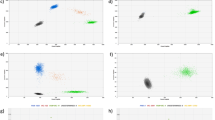Abstract
Purpose
Amplification of neuroblastoma derived (avian) v-myc myelocytomatosis viral related oncogene (MYCN) is an important risk-stratified indicator in neuroblastoma. To evaluate the feasibility of noninvasive measurement of MYCN amplification, we analyzed MYCN amplification in stored blood plasma samples.
Methods
We used quantitative real-time PCR to determine MYCN copy numbers in plasma-derived DNA of 10 healthy volunteers and 50 neuroblastoma cases. The copy number was calculated as the ratio of copies of MYCN to those of a reference gene. Plasma samples obtained after surgery or neoadjuvant therapy were also analyzed in five cases and four cases, respectively.
Results
In 34 neuroblastoma cases, MYCN was non-amplified in both tumor tissue and blood plasma. In 16 neuroblastoma cases, MYCN was amplified in both tumor tissue and blood plasma; 13 of the 16 cases showed poor outcomes. MYCN amplification was undetectable in blood plasma shortly after surgery or neoadjuvant therapy. The correlation coefficient between MYCN copy numbers in tumor tissue and in blood plasma was approximately 0.9.
Conclusion
We can detect MYCN amplification of tumor tissue noninvasively and quantitatively by measuring the MYCN copy number in blood plasma. Determination of MYCN copy number in plasma may be useful when evaluating surgery and neoadjuvant chemotherapy.




Similar content being viewed by others
References
Ohtsu K, Hiyama E, Ichikawa T, Matsuura Y, Yokoyama T (1997) Clinical Investigation of neuroblastoma with partial deletion in the short arm of chromosome 1. Clin Cancer Res 3:1221–1228
Hiyama E, Hiyama K, Ohtsu K, Yamaoka H, Fukuba I, Matsuura Y, Yokoyama T (2001) Biological characteristics of neuroblastoma with partial deletion in the short arm of chromosome 1. Med Pediatr Oncol 36:67–74
Plantaz D, Mohapatra G, Matthay KK, Pellarin M, Seeger RC, Feuerstein BG (1997) Gain of chromosome 17 is the most frequent abnormality detected in neuroblastoma by comparative genomic hybridization. Am J Pathol 150:81–89
Maris JM, Guo C, White PS, Hogarty MD, Thompson PM, Stram DO, Gerbing R, Matthay KK, Seeger RC, Brodeur GM (2001) Allelic deletion at chromosome bands 11q14-23 is common in neuroblastoma. Med Pediatr Oncol 36:24–27
Hiyama E, Yokoyama T, Ichikawa T, Ishii T, Hiyama K (1990) N-myc gene amplification and other prognostic associated factors in neuroblastoma. J Pediatr Surg 25:1095–1099
Ambros PF, Ambros IM, Brodeur GM, Haber M, Khan J, Nakagawara A, Schleiermacher G, Speleman F, Spitz R, London WB, Cohn SL, Pearson AD, Maris JM (2009) International consensus for neuroblastoma molecular diagnostics: report from the international neuroblastoma risk group (INRG) Biology Committee. Br J Cancer 100:1471–1482
Kaneko M, Tsuchida Y, Uchino J, Takeda T, Iwafuchi M, Ohnuma N, Mugishima H, Yokoyama J, Nishihira H, Nakada K, Sasaki S, Sawada T, Kawa K, Nagahara N, Suita S, Sawaguchi S (1999) Treatment results of advanced neuroblastoma with the first Japanese study group protocol. Study Group of Japan for Treatment of Advanced Neuroblastoma. J Pediatr Hematol Oncol 21:190–197
Hiyama E, Hiyama K, Yokoyama T (1991) Neuroblastoma with DNA amplification and rearrangement in the N-myc gene region. Cancer Res 51:1946–1951
Hiyama E, Hiyama K (2009) Diagnostic and prognostic molecular markers in neuroblastoma, 1st edn. Transworld Research Network, Kerala
Gotoh T, Hosoi H, Iehara T, Kuwahara Y, Osone S, Tsuchiya K, Ohira M, Nakagawara A, Kuroda H, Sugimoto T (2005) Prediction of MYCN amplification in neuroblastoma using serum DNA and real-time quantitative polymerase chain reaction. J Clin Oncol 23:5205–5210
Hiyama E, Hiyama K (2005) Molecular and biological heterogeneity in neuroblastoma. Curr Genomics 6:319–332
Nigro JM, Baker SJ, Preisinger AC, Jessup JM, Hostetter R, Cleary K, Bigner SH, Davidson N, Baylin S, Devilee P, Glover T, Collins FS, Weston A, Modali R, Harris CC, Vogelstein B (1989) Mutations in the p53 gene occur in diverse human tumour types. Nature 342:705–708
Kopreski MS, Benko FA, Kwee C, Leitzel KE, Eskander E, Lipton A, Gocke CD (1997) Detection of mutant K-ras DNA in plasma or serum of patients with colorectal cancer. Br J Cancer 76:1293–1299
Chiang PW, Beer DG, Wei WL, Orringer MB, Kurnit DM (1999) Detection of erbB-2 amplifications in tumors and sera from esophageal carcinoma patients. Clin Cancer Res 5:1381–1386
Combaret V, Audoynaud C, Iacono I, Favrot MC, Schell M, Bergeron C, Puisieux A (2002) Circulating MYCN DNA as a tumor-specific marker in neuroblastoma patients. Cancer Res 62:3646–3648
Acknowledgments
Supported by Grant-in-Aid for Scientific Research (A) from the Ministry of Education, Culture, Sports, Science and Technology (MEXT) of Japan.
Conflict of interest
The authors declare that they have no conflict of interest.
Author information
Authors and Affiliations
Corresponding author
Rights and permissions
About this article
Cite this article
Kojima, M., Hiyama, E., Fukuba, I. et al. Detection of MYCN amplification using blood plasma: noninvasive therapy evaluation and prediction of prognosis in neuroblastoma. Pediatr Surg Int 29, 1139–1145 (2013). https://doi.org/10.1007/s00383-013-3374-9
Published:
Issue Date:
DOI: https://doi.org/10.1007/s00383-013-3374-9




